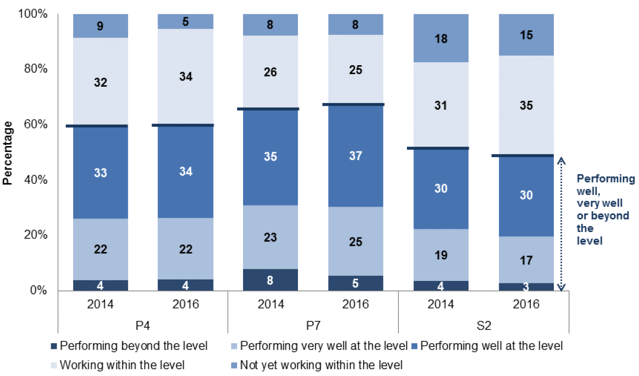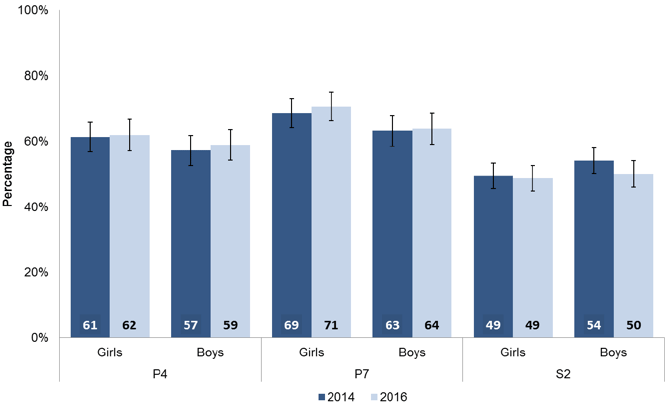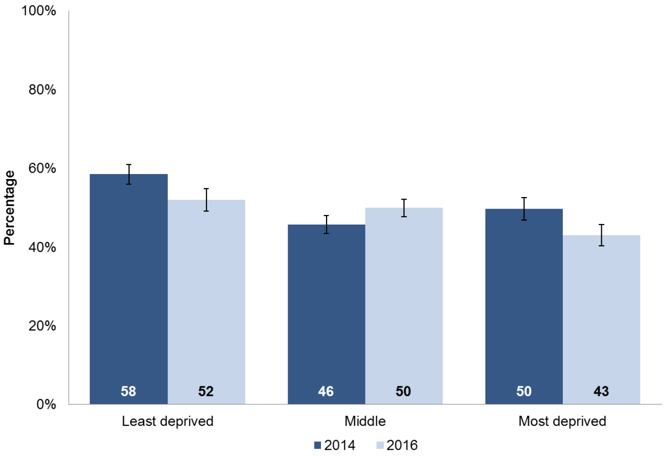Scottish Survey of Literacy and Numeracy 2016: literacy
Literacy results from the 2016 survey which covers assessment of school pupils at various stages in primary and secondary school.
Chapter 7: Listening and talking attainment over time
- Listening and talking performance in 2016 was similar to that in 2014, at all stages.
- Girls outperformed boys in P7 in 2016; there were no other statistically significant differences in performance between girls and boys in either 2014 or 2016.
- Pupils from the least deprived areas outperformed pupils from the most deprived areas at all stages in 2014 and 2016. The size of the gap in performance has not changed between 2014 and 2016.
7.1 Methodology
In 2012, there were difficulties in administering the group discussion assessments; mainly due to technical and practical issues. A new approach was implemented for the 2014 and 2016 surveys as described in Section 6.1. Due to the different assessment approaches, no comparisons can made between 2012 and 2014 listening and talking results, however 2014 and 2016 results are directly comparable.
7.2 Listening and talking attainment over time
Chart 7.1 shows listening and talking performance by reporting categories and stage, over two literacy surveys: 2014 and 2016.
Chart 7.1: Listening and talking performance by reporting category and stage, 2012, 2014 and 2016

There were no statistically significant differences in the proportions of P4, P7 or S2 pupils performing well, very well or beyond the level between 2014 and 2016. In P4, the proportion of pupils who were assessed as not yet working within the level fell from nine per cent in 2014 to five per cent in 2016. In S2, those assessed as working within the level rose from 31 per cent to 35 per cent over the same time period. There were no other significant changes between 2014 and 2016.
7.3 Attainment by gender
There were no significant changes in the proportion of boys or girls performing well, very well or beyond the level in listening and talking between 2014 and 2016.
For girls, the only significant changes seen in listening and talking performance between 2014 and 2016 are in P4. The proportion of P4 girls performing very well at the level fell seven percentage points whilst those performing well at the level rose eight percentage points.
For boys, there were significant changes in some performance levels at each stage; although there is no obvious pattern that is consistent across the stages. In P4 the proportion of boys performing very well at the level rose seven percentage points whilst those not yet working within the level fell three percentage points. In P7 the proportion of boys performing beyond the level fell four percentage points. Finally, at S2 the proportion of boys working within the level rose five percentage points.
Chart 7.2: Proportion of pupils performing well, very well or beyond the level in listening and talking, by gender and stage, 2014 and 2016

The gender gap in performance that exists at P7 (not P4 or S2) is statistically similar to the size of the gap in 2014.
7.4 Attainment by deprivation
There were no significant changes in the proportion of pupils performing well, very well or beyond the level in listening and talking for any deprivation category.
Among the least deprived, the proportion of P7 pupils performing very well at the level rose nine per cent and, at S2, the proportion of pupils working within the level rose eight per cent. There are no other significant differences between 2014 and 2016 performance for the pupils from the least deprived category.
In the middle category the only significant change was a four per cent fall in the proportion of P7 pupils performing beyond the level.
Among the most deprived, the proportion of P7 pupils performing well at the level rose nine per cent. Whereas at S2, the proportion of pupils performing very well at the level fell six per cent. There are no other significant differences between 2014 and 2016 performance for the pupils from the most deprived category.
Chart 7.3: Proportion of S2 pupils performing well, very well or beyond the level, by deprivation category and stage, 2014 and 2016

Table 7.2: Difference in performance by listening and talking deprivation category in 2014 and 2016, by stage
Deprivation gap (least deprived minus most deprived)
| Stage |
2014 |
2016 |
2014 to 2016 |
|---|---|---|---|
| P4 |
14 |
14 |
No difference |
| P7 |
13 |
14 |
No difference |
| S2 |
9 |
9 |
No difference |
The pattern of performance by deprivation over time is stable, in that a performance gap continues to exist across all stages. There were no significant changes in the size of the deprivation gap in listening and talking between 2014 and 2016.
Contact
Email: Marion MacRury
Phone: 0300 244 4000 – Central Enquiry Unit
The Scottish Government
St Andrew's House
Regent Road
Edinburgh
EH1 3DG
There is a problem
Thanks for your feedback